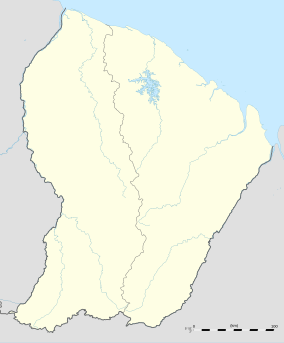Amana Nature Reserve
| Amana Nature Reserve | |
|---|---|
IUCN category IV (habitat/species management area) | |
 | |
| Location | French Guiana, France |
| Nearest city | Awala-Yalimapo |
| Coordinates | 5°44′30″N 53°53′34″W / 5.7417°N 53.8927°W |
| Area | 148 km2 (57 sq mi)[1] |
| Established | 13 March 1998[1] |
| Governing body | Regional Natural Park of French Guiana |
| Website | Reserves-Naturelles.org (in French) |
The Amana Nature Reserve (French: Réserve naturelle nationale de l'Amana) is a nature reserve in French Guiana, France.[2] It has been protected because it is one of the world's largest leatherback sea turtle nesting sites.[3][4] It is part of the communes of Awala-Yalimapo and Mana.[1]
Environment
[edit]The nature reserve stretches from the Maroni to the Organobo River. The reserve consists of beaches, mangrove forests, swamps and savannas.[2]

Turtles
[edit]Leatherback sea turtles need very specific nesting beaches, and return to the same beach every two to three years. It is an vulnerable species with a limited number of suitable beaches.[5] The neighbouring Wia Wia Nature Reserve in Suriname was used by the turtles as well until the beach shifted resulting in the disappearance of the turtles.[6]
The beaches at Amana were home to 5,029 to 63,294 nests between 1967 and 2005.[5] The turtles lay their eggs between March and July, digging a hole in the sand in which they lay 80 to 90 eggs. The hole is located between the high-water mark and the vegetation. The baby turtles emerge about two months later.[7]
Other turtles nesting on the beach are the green, olive ridley and, occasionally, hawksbill sea turtles.[2]
Birds
[edit]The reserve has been designated an Important Bird Area (IBA) by BirdLife International because it supports significant populations of many birds, especially migratory waders and other waterbirds, among 319 species recorded.[8]
References
[edit]- ^ a b c "L'Amana". Inventaire National du Patrimoine Naturel (in French). Retrieved 15 March 2021.
- ^ a b c "Amana". Reserves Naturelles (in French). Retrieved 15 March 2021.
- ^ "Mana, précurseurse depuis toujours". Le Jour du Seigneur (in French). Retrieved 15 March 2021.
- ^ Sabrina Fossettea (2008). "The world's largest leatherback rookeries: A review of conservation-oriented research in French Guiana/Suriname and Gabon". Journal of Experimental Marine Biology and Ecology. 356 (1–2): 69–82. doi:10.1016/j.jembe.2007.12.024.
- ^ a b "Leatherback Sea Turtle (Dermochelys coriacea)". North Florida Ecological Services Office. Retrieved 15 March 2021.
- ^ Ouboter, Paul E. (2001). "Directory of protected areas of Suriname". IBER. p. 11.
- ^ Alexandra Maros (2006). "Evidence of the exploitation of marine resource by the terrestrial insect Scapteriscus didactylus through stable isotope analyzes of its cuticle". BMC Ecology. 6: 6. doi:10.1186/1472-6785-6-6. PMC 1533807. PMID 16681850.
- ^ "Amana". BirdLife Data Zone. BirdLife International. 2024. Retrieved 2024-09-28.
External links
[edit]- Official website (in French)

